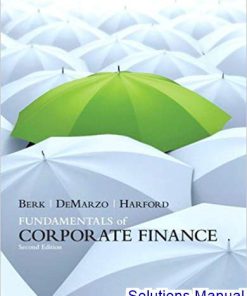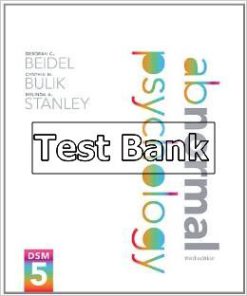Corporate Finance Canadian 2nd Edition Berk Test Bank
You may also like
Corporate Finance Canadian 2nd Edition Berk Test Bank

Product details:
- ISBN-10 : 0321761928
- ISBN-13 : 978-0321761927
- Author:
Directly connecting theory to practice, Corporate Finance uses the Law of One Price as a compass keeping financial decision makers on the right track. This unified approach equips students with the core financial concepts and tools needed to make good decisions. Covering unique Canadian topics such as, Canadian tax issues, discussion of income trust and clear and comprehensive integration of capital cost allowance meets the needs of both future financial and nonfinancial managers.
Table contents:
CHAPTER 1 Corporate Governance 1
Learning Outcomes 1
1. Introduction 1
2. Corporate Governance: Objectives and Guiding Principles 2
3. Forms of Business and Conflicts of Interest 3
3.1. Sole Proprietorships 4
3.2. Partnerships 5
3.3. Corporations 5
4. Specific Sources of Conflict: Agency Relationships 6
4.1. Manager–Shareholder Conflicts 6
4.2. Director–Shareholder Conflicts 10
5. Corporate Governance Evaluation 10
5.1. The Board of Directors 11
5.2. Examples of Codes of Corporate Governance 24
6. Environmental, Social, and Governance Factors 37
7. Valuation Implications of Corporate Governance 39
8. Summary 40
Problems 42
CHAPTER 2 Capital Budgeting 47
Learning Outcomes 47
1. Introduction 48
2. The Capital Budgeting Process 49
3. Basic Principles of Capital Budgeting 50
4. Investment Decision Criteria 52
4.1. Net Present Value 52
4.2. Internal Rate of Return 53
4.3. Payback Period 55
4.4. Discounted Payback Period 57
4.5. Average Accounting Rate of Return 58
4.6. Profitability Index 58
4.7. NPV Profile 59
4.8. Ranking Conflicts between NPV and IRR 61
4.9. The Multiple IRR Problem and the No IRR Problem 65
4.10. Popularity and Usage of the Capital Budgeting Methods 68
5. Cash Flow Projections 70
5.1. Table Format with Cash Flows Collected by Year 70
5.2. Table Format with Cash Flows Collected by Type 72
5.3. Equation Format for Organizing Cash Flows 72
6. More on Cash Flow Projections 74
6.1. Straight-Line and Accelerated Depreciation Methods 74
6.2. Cash Flows for a Replacement Project 77
6.3. Spreadsheet Modeling 79
6.4. Effects of Inflation on Capital Budgeting Analysis 81
7. Project Analysis and Evaluation 82
7.1. Mutually Exclusive Projects with Unequal Lives 82
7.2. Capital Rationing 84
7.3. Risk Analysis of Capital Investments—Standalone Methods 86
7.4. Risk Analysis of Capital Investments—Market Risk Methods 92
7.5. Real Options 95
7.6. Common Capital Budgeting Pitfalls 99
8. Other Income Measures and Valuation Models 101
8.1. The Basic Capital Budgeting Model 101
8.2. Economic and Accounting Income 102
8.3. Economic Profit, Residual Income, and Claims Valuation 106
9. Summary 110
Problems 113
CHAPTER 3 Cost of Capital 127
Learning Outcomes 127
1. Introduction 128
2. Cost of Capital 128
2.1. Taxes and the Cost of Capital 129
2.2. Weights of the Weighted Average 131
2.3. Applying the Cost of Capital to Capital Budgeting and Security Valuation 133
3. Costs of the Different Sources of Capital 135
3.1. Cost of Debt 135
3.2. Cost of Preferred Stock 138
3.3. Cost of Common Equity 140
4. Topics in Cost of Capital Estimation 146
4.1. Estimating Beta and Determining a Project Beta 146
4.2. Country Risk 153
4.3. Marginal Cost of Capital Schedule 154
4.4. Flotation Costs 157
4.5. What Do CFOs Do? 160
5. Summary 160
Problems 163
CHAPTER 4 Measures of Leverage 171
Learning Outcomes 171
1. Introduction 171
2. Leverage 172
3. Business Risk and Financial Risk 173
3.1. Business Risk and Its Components 174
3.2. Sales Risk 174
3.3. Operating Risk 176
3.4. Financial Risk 182
3.5. Total Leverage 184
3.6. Breakeven Points and Operating Breakeven Points 189
3.7. The Risks of Creditors and Owners 191
4. Summary 194
Problems 194
CHAPTER 5 Capital Structure 199
Learning Outcomes 199
1. Introduction 199
2. The Capital Structure Decision 200
2.1. Proposition I without Taxes: Capital Structure Irrelevance 201
2.2. Proposition II without Taxes: Higher Financial Leverage Raises the Cost of Equity 203
2.3. Taxes, the Cost of Capital, and the Value of the Company 205
2.4. Costs of Financial Distress 210
2.5. Agency Costs 211
2.6. Costs of Asymmetric Information 212
2.7. The Optimal Capital Structure According to the Static Trade-Off Theory 213
3. Practical Issues in Capital Structure Policy 216
3.1. Debt Ratings 216
3.2. Evaluating Capital Structure Policy 217
3.3. Leverage in an International Setting 218
4. Summary 222
Problems 223
CHAPTER 6 Dividends and Share Repurchases: Basics 229
Learning Outcomes 229
1. Introduction 229
2. Dividends: Forms 230
2.1. Regular Cash Dividends 231
2.2. Extra or Special (Irregular) Dividends 232
2.3. Liquidating Dividends 234
2.4. Stock Dividends 234
2.5. Stock Splits 236
3. Dividends: Payment Chronology 238
3.1. Declaration Date 238
3.2. Ex-Dividend Date 238
3.3. Holder-of-Record Date 239
3.4. Payment Date 239
3.5. Interval between Key Dates in the Dividend Payment Chronology 239
4. Share Repurchases 241
4.1. Share Repurchase Methods 243
4.2. Financial Statement Effects of Repurchases 245
4.3. Valuation Equivalence of Cash Dividends and Share Repurchases: The Baseline 249
5. Concluding Remarks 250
6. Summary 251
Problems 252
CHAPTER 7 Dividends and Share Repurchases: Analysis 257
Learning Outcomes 257
1. Introduction 258
2. Dividend Policy and Company Value: Theory 258
2.1. Dividend Policy Does Not Matter 258
2.2. Dividend Policy Matters: The Bird-in-the-Hand Argument 260
2.3. Dividend Policy Matters: The Tax Argument 260
2.4. Other Theoretical Issues 261
2.5. Dividend Theory: Summary 271
3. Factors Affecting Dividend Policy 271
3.1. Investment Opportunities 272
3.2. The Expected Volatility of Future Earnings 272
3.3. Financial Flexibility 273
3.4. Tax Considerations 273
3.5. Flotation Costs 276
3.6. Contractual and Legal Restrictions 277
3.7. Factors Affecting Dividend Policy: Summary 278
4. Payout Policies 279
4.1. Types of Dividend Policies 279
4.2. The Dividend versus Share Repurchase Decision 285
4.3. Global Trends in Payout Policy 291
5. Analysis of Dividend Safety 293
6. Summary 297
Problems 298
CHAPTER 8 Working Capital Management 303
Learning Outcomes 303
1. Introduction 304
2. Managing and Measuring Liquidity 305
2.1. Defining Liquidity Management 305
2.2. Measuring Liquidity 307
3. Managing the Cash Position 312
3.1. Forecasting Short-Term Cash Flows 313
3.2. Monitoring Cash Uses and Levels 315
4. Investing Short-Term Funds 316
4.1. Short-Term Investment Instruments 316
4.2. Strategies 320
4.3. Evaluating Short-Term Funds Management 322
5. Managing Accounts Receivable 323
5.1. Key Elements of the Trade Credit Granting Process 324
5.2. Managing Customers’ Receipts 326
5.3. Evaluating Accounts Receivable Management 328
6. Managing Inventory 330
6.1. Approaches to Managing Levels of Inventory 331
6.2. Inventory Costs 332
6.3. Evaluating Inventory Management 332
7. Managing Accounts Payable 334
7.1. The Economics of Taking a Trade Discount 335
7.2. Managing Cash Disbursements 336
7.3. Evaluating Accounts Payable Management 337
8. Managing Short-Term Financing 337
8.1. Sources of Short-Term Financing 337
8.2. Short-Term Borrowing Approaches 339
8.3. Asset-Based Loans 340
8.4. Computing the Costs of Borrowing 341
9. Summary 343
Problems 344
CHAPTER 9 Financial Statement Analysis 347
Learning Outcomes 347
1. Introduction 347
2. Common-Size Analysis 348
2.1. Vertical Common-Size Analysis 350
2.2. Horizontal Common-Size Analysis 353
3. Financial Ratio Analysis 356
3.1. Activity Ratios 357
3.2. Liquidity Analysis 363
3.3. Solvency Analysis 365
3.4. Profitability Analysis 369
3.5. Other Ratios 383
3.6. Effective Use of Ratio Analysis 386
4. Pro Forma Analysis 392
4.1. Estimating the Sales-Driven Relations 395
4.2. Estimating the Fixed Burdens 396
4.3. Forecasting Revenues 397
4.4. Constructing Pro Forma Statements 397
5. Summary 401
Problems 402
CHAPTER 10 Mergers and Acquisitions 407
Learning Outcomes 407
1. Introduction 408
2. Mergers and Acquisitions: Definitions and Classifications 410
3. Motives for Merger 413
3.1. Synergy 413
3.2. Growth 413
3.3. Increasing Market Power 414
3.4. Acquiring Unique Capabilities and Resources 414
3.5. Diversification 414
3.6. Bootstrapping Earnings 415
3.7. Managers’ Personal Incentives 416
3.8. Tax Considerations 416
3.9. Unlocking Hidden Value 416
3.10. Cross-Border Motivations 417
4. Transaction Characteristics 418
4.1. Form of Acquisition 419
4.2. Method of Payment 420
4.3. Mind-Set of Target Management 422
5. Takeovers 424
5.1. Pre-Offer Takeover Defense Mechanisms 424
5.2. Post-Offer Takeover Defense Mechanisms 426
6. Regulation 429
6.1. Antitrust 430
6.2. Securities Laws 433
7. Merger Analysis 434
7.1. Target Company Valuation 434
7.2. Bid Evaluation 446
8. Who Benefits from Mergers? 450
9. Corporate Restructuring 451
10. Summary 452
Problems 454
Glossary 463
References 475
About the Authors 481
About the CFA Program 487
Index 489
People also search:
corporate finance and canadian law
corporate finance and canadian law
canadian corporate tax return due date
fundamentals of corporate finance canadian edition
a canadian corporation












